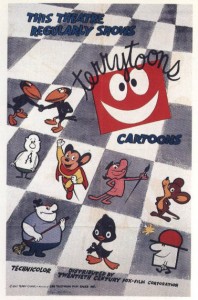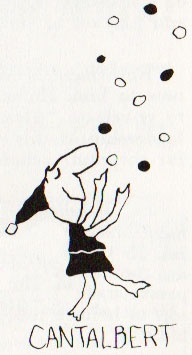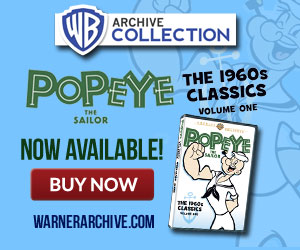 In 1956 I was given the opportunity to become the creative leader of the reborn CBS-Terrytoons studio! The greatest lure were those 18 blank CinemaScope screens for 20th Century-Fox that had to be filled each year!
In 1956 I was given the opportunity to become the creative leader of the reborn CBS-Terrytoons studio! The greatest lure were those 18 blank CinemaScope screens for 20th Century-Fox that had to be filled each year!
Those were still the times when at least one cartoon short was on every movie theater program. Their running had to be contained on one 10-minute reel of 35mm film. They usually ran about six minutes. Every major movie studio had a cartoonproduction usually right on their lot; Disney, of course, with Silly Symphonies, and Warner Brothers had Merrie Melodies and Columbia had Color Rhapsodies. 20th Century-Fox had Terrytoons.
At first thought, it seemed to be the most wonderful opportunity and challenge any animator could wish for. I was at the cusp of my career as an animation director at that time and combined my passion for making movie cartoons with an equal passion for pushing the technological envelope. Of course, I had no idea of what an explosion of animation technology would be coming 40 years later in age of 3D CGI. But in 1956 CinemaScope, and other ultra wide screen, seemed to be the Big Thing.
Before the appearance IMAX, the public was totally flummoxed into believing that a widescreen shape was somehow more realistic of what we see around us than the “classic” movie 4×5 screen shape, established almost from the beginnings ofcinema. It was a shape echoing the “landscape” shape of most paintings seen in museums, thus adding a classy look to the movies. Ironically, budding television went after the same movie screen shape. It was necessary for TV if they wanted to run movies. But then, as we know, the threatened movie makers went to multiplex, movie palaces with wider and higher screens, and now I have at home a 48 inch wide, wall-mounted flatscreen TV, nothing special as I write this.
 But what does it all mean? In the centuries of graphic art, how many paintings in museums have a “CinemaScope” shape, markedly wider than high? The only real reason for the shape was to be “different from television,” but I soon found the that extreme wide shape no good for animation that had to eventually be shown on TV, so we had to ignore the assumed “added”possibilities” of a wide screen, and keep all our action in the safety center!
But what does it all mean? In the centuries of graphic art, how many paintings in museums have a “CinemaScope” shape, markedly wider than high? The only real reason for the shape was to be “different from television,” but I soon found the that extreme wide shape no good for animation that had to eventually be shown on TV, so we had to ignore the assumed “added”possibilities” of a wide screen, and keep all our action in the safety center!
It was only after I got into it that I realized the downside of wide screen for cartoon movies.. Soon after I got started working with this format that I was faced withsome depressing truths; Number One, it became obvious that the real reason CBS bought Terrytoons was not because they wanted to convert that musty old studio into another UPA, and raise the level of animation creativity… Not exactly.
What they really wanted was the vast library of previously produced mediocre Terrytoons cartoons to fill their TV programming. So the goals of CBS, 20thCentury-Fox, and Deitch were all at odds.
20th-Century Fox were the inventors of CinemScope and insisted that Terrytoons should henceforth all be produced in the CinemaScope format, and thus give their cartoons a box office edge, promote the CinemaScope format, and thus 20th Century-Fox. CBS wanted cartoons to be produced that could run on TV. So they insisted that all the essential action be within the central portion of the screen – within the limited TV “safety” field – and that the wide sides of the screen could be cut off without losing the essential action. How could we possibly create good screen design, with no control over the various ways our cartoon would be screened.
I wanted to exploit the entire wide screen area to bring an added dimension to movie cartoons, and to widen their effect, but it was all all clumsy compromise. Obviously, these three divergent goals could not be successfully reconciled — but it did not stop me from trying!
The creative benefits of the very wide screen were markedly diminished by the limitations. We could not even use the most fundamental dramatic camera moves, rotating angle shots. The moment we would rotate the camera, the wide edges ofour animation field would swing out of camera range! We could only rotate the camera at very small field sizes where we would lose image sharpness. So basically, we could only handle straight – on shots, losing a basic cinematic tool.
 Another limitation was the same as in live – action CinemaScope movies. The very wide screen favored long shots, and made close ups jarring. It drastically limited the most basic element of our craft: film editing. We had to stay with longer running shots, with action within the frame, and limit cuts and close-ups. So with all the conflicting demands of TV and distributors, CinemaScope was more a hindrance than a blessing. Deft editing is the very basis of cinematic art, which was actually better in the age of silent films, when the imagehad to say everything, and we wanted the least possible dialog, Of course today the soundtrack is at least half the film, but in interaction, not domination.
Another limitation was the same as in live – action CinemaScope movies. The very wide screen favored long shots, and made close ups jarring. It drastically limited the most basic element of our craft: film editing. We had to stay with longer running shots, with action within the frame, and limit cuts and close-ups. So with all the conflicting demands of TV and distributors, CinemaScope was more a hindrance than a blessing. Deft editing is the very basis of cinematic art, which was actually better in the age of silent films, when the imagehad to say everything, and we wanted the least possible dialog, Of course today the soundtrack is at least half the film, but in interaction, not domination.
In spite of all this, I did my best to fight it. I was determined to sneak as much benefit as I could from the CinemaScope format I was stuck with, and that was probably one of the things that soon led to my undoing at Terrytoons.
As I remember, there were just two films that gave me a chance to really exploit the wide screen format, the Dinky Duck film, It’s a Living, and the R.O.Blechman story, The Juggler of Our Lady. Dinky Duck was the only standard Terrytoons character that I ever used, and just that one time. With the story that Tommy Morrison, the story staff, and I created, we had a chance to do a satire on the old Terrytoons shtick, and to call direct attention to the CinemaScope screen shape. I still think it was an effective satire, in the mid-1950s. In recent years Disney did a masterful extension of my Dinky Duck satire, idea with a spectacular 3D Mickey Mouse movie, using the original character models in a wild hi-tech way. Each generation ups the ante!
When I first saw R.O.Blechman’s little book, “The Juggler of Our Lady,” with every word, including the title and copyright notice hand written in Bob’s tiny and shaky style, I thought that here was the greatest opportunity I would ever have to really have fun with the CinemaScope format, playing off those tiny timorous figures against the vast expanse of that very wide screen! But it was the toughest sell I ever had – not only to convince Bill Weiss of the value of such a film to the studio’s image, but also to get Bob to let us do it.
 Blechman was well aware of the old Terrytoons product, and was terrified we would convert his little juggler into Mighty Mouse. I was on the phone with Bob every night for nearly a year before he finally relented. I assured him over and over again, that we would be absolutely true to his story and faithful to his graphic style.
Blechman was well aware of the old Terrytoons product, and was terrified we would convert his little juggler into Mighty Mouse. I was on the phone with Bob every night for nearly a year before he finally relented. I assured him over and over again, that we would be absolutely true to his story and faithful to his graphic style.
My ace card was Al Kouzel, one of the finest animators who ever worked with me. I knew that I could rely on Al to perfectly get Bob Blechman’s images unscathed onto the big screen. Al was a talented and dedicated artist who worked with me for many years in many locations, even in Prague. He was able to get Bob’s confidence. They meshed. It was a prodigious undertaking, and Bob himself came into the studio to work with Al on the layouts. I monitored and guided the visual staging development each day. I knew this had to work, and bring us needed prestige, or I would be finished at Terrytoons immediately.
Besides the graphic fidelity, there were the other filmic elements to co-ordinate – the music and the narration. I had to work with the long-time Terrytoons musical director, Phil Sheib, a fixture in the studio for many, many years, who had ground out hundreds of ossified and clichéd musical scores for the standard Terrytoons of old. I spent hours working with him and assuring him that I would allow him to break out of the Paul Terry restrictions he had been working with for so long. Paul had insisted that if he was paying for a 30-piece orchestra, he wanted every musician – to – be – playing – all -the – time! That forced those wacky, overblown arrangements you hear on the typical old Terrytoons. Phil was a former piano player for silent movie theaters, and had developed a heavy-handed, clichéd output. But he truly surprised me by showing that he was in fact a great musician who, being set free, could create spare, funny, and lovely film scores.
I think his “Juggler” music is the best thing he ever did, and it was just, at my instruction, a woodwind quintet! I like to think that my greatest inspiration for the film was in the choice of Boris Karloff as the narrator. I was jeered at for choosing this typecast movie monster for such a delicate story as “The Juggler,” but I had a hunch, from hearing him speak on the radio, and realizing that he was actually a gentle and cultured Englishman. I immediately felt that he was the one, and when I contacted him, he was eager to do it, and break out of his stereotyped monster image.
These two films worked, but as I said, the successes were exceptions. I realized once again that all this CinemaScope stuff, or any other high-tech gizmo, were merely superficial, and that the only thing that really counted would be strong stories, fresh characters, and brilliant animation.
That was my basic endeavor, and the only factors these cartoons could be judged by. My sad admission is that only a few of the CinemaScope cartoons I managed to produce at Terrytoons lived up to my expectations.

NEXT WEEK: The Final Days at Terrytoons.



 Gene Deitch is a cartoonist and Oscar winning animator who created such beloved characters as Tom Terrific, Silly Sidney and Nudnik. Gene was the director of UPA New York, the creative supervisor at Terrytoons (1956-58) and the acclaimed producer of hundreds of shorts for Weston Woods. He passed away April 17th, 2020, in Prague.
Gene Deitch is a cartoonist and Oscar winning animator who created such beloved characters as Tom Terrific, Silly Sidney and Nudnik. Gene was the director of UPA New York, the creative supervisor at Terrytoons (1956-58) and the acclaimed producer of hundreds of shorts for Weston Woods. He passed away April 17th, 2020, in Prague.











































“It’s a Living” is my all-time favorite Terrytoon because of its self-awarness, and the reminder they TV ads 60 years ago were as hokey as they are today. Allen Swift’s work as the voiceover announcer on the loopy ads is also great.
You could see even in the earliest of the Terrytoons CinemaScope efforts that while the backgrounds were wider, virtually all the action remained within the standard Academy ratio area. That was also true of the first year or so of Hanna-Barbera’s Tom & Jerry CinemaScopes that MGM also released in the Academy ratio format. Once they quit doing that in the final two seasons of releases, they started using more of the outer edges of the screen for action (in hindsight for today’s HDTVs, Paramount’s VistaVision had an aspect ratio that would have worked a lot better than CinemaScope did in widening the screen, but not insanely so. Too bad Paramount never let their cartoon studio do any VistaVision releases).
“The only thing that really counted would be strong stories, fresh characters, and brilliant animation.”
Yes.
It would have been neat to have seen you and others actually able to use the CinemaScope screen.
I remember being floored by a Russian wide screen film of HAMLET that luxuriated in use of the screen.
Thanks for sharing. JUGGLER is gorgeous. No one narrated better than Karloff.
“What they really wanted was the vast library of previously produced mediocre Terrytoons cartoons to fill their TV programming”
Oh I feel you there. in my opinion, in this great grand valley of classic animation, Terry Toons are one of those things that I dont think is exactly the best stuff around. Like, a lot of the characters are not too original / beat-for-beat repeats of characters from other (More popular) studios, and many of the shorts are kind of forgettable and dont resonate with me as much as others from say WB / Fleischer / Disney.
Of course you know I love your work, Gene, especially Tom Terrific, Juggler of Our Lady and “The Flamboyant Arms”, among many others. However, I feel you are not doing a service to animation history by continually denigrating the older Terrytoons cartoons. Keep in mind that CBS when they acquired the library, actually cut one to two minutes out of the Terrytoons, to keep them all at about 5 minutes for the convenience of television programs and to allow extra time for commercials.Consequently, a majority of the early Terrytoons sound cartoons haven’t been seen uncut since their original nitrate theatrical releases. CBS also censored many of the more “adult” gags, filling the missing spaces in the cartoons by repeating scenes. The early silent Aesop’s Fables had many funny moments with Al Falfa and the farm animals, and just to take two examples, “Hollywood Diet” from 1932 with the Phil Sheib song “Laugh and Grow Thin” was an effective satire on dieting. “The Banker’s Daughter” from 1933, which kicked off the Fanny Zilch cartoon serial, which no other cartoon studio attempted in the theatrical era, drew inspiration from Verdi and Puccini operatic arias, showing off Sheib’s classical side, and influencing the sound of Terrytoons well into the Mighty Mouse era. Roy Halee did bravura arias as Mighty Mouse. The score for “Juggler” is charming, but Phil Sheib created many outstanding musical moments in Terrytoons over the years. “Krakatoa Katie” from 1945’s “Mighty Mouse in Krakatoa”, is an unforgettable song. There are so many I like, this is just a simple sample.
The music did indeed get routinely unremarkable at a certain point, but agreed: Sheib was undeniably ambitious in his scores for the first half of the ’30s, and there were many gems thereafter.
Astoundingly, this is the very first time I have ever seen or even heard of such a lamebrain gimmik as “Cinemacs!” And these are my own cartoons,but not “cenemaxed by me ! Only the tireless collector, Jerry Beck, could come up with such wacko oddities! Were these examples actually distributed, or were they only demo samples; just experiments? Whatever, these samples actually contort the cartoons, but add nothing more than vertigo!
Thanks Gene!
You really did breathe new life into a sleepy old cartoon studio.
Doubly fortunate that you could team up with Jim Tyer.
“The Juggler of Our Lady” is a wonderful cartoon, a must have for everyone’s holiday cartoon collection (although Blechman comes close to topping it a decade later with his brief “Season’s Greetings from CBS” offering). Boris Karloff’s gentle narration is as ideal as it gets.